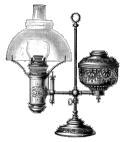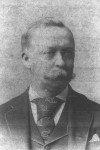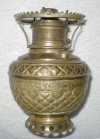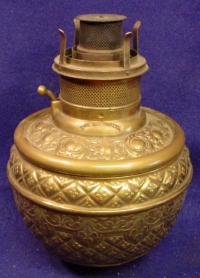
A heavily embossed ROCHESTER lamp fount and receiver from a banquet or piano lamp. |
Charles Stanford Upton was born on November 24, 1844. He was an avid reader and spent many evenings with a good book. Dissatisfied with the inadequate amount of light produced by the flat wick kerosene lamp, he theorized that three or four wicks sewn together into a tube would give several times the light of the flat wick lamp. He arranged to meet
Leonard Henkle at the Powers Hotel in Rochester to discuss his idea. As ideas were bounced around, they were trying to think of a way to make a model. The two men noticed the tin cuspidors on the floor of the hotel and a light went off - literally! Learning where the cuspidors could be purchased, the two hurried off to the hardware store of Hamilton and Matthews on Exchange Street. With two spittoons in hand, the two men hastened to Henkle's repair shop on Water Street, where, after much experimentation, they produced a working model.
In 1884 he organized
The Rochester Lamp Company, serving as both manager and president. Upton bought the manufacturing rights to Leonard Henkle's patent #292,114, dated January 15, 1884, for improvements in the air distribution of center draft lamps - the perforated thimble, or flame spreader, as it is often called today. Upton christened the lamp "The Rochester," presumably after the city in which he lived. Upton open lamp stores and set about aggressively marketing his product. The "Rochester" would become one of the best designed and best made center draft lamps of the era.
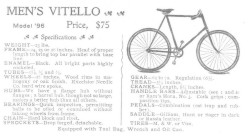 |
Advertisement for Upton's Men's Vitello Bicycle. It cost $75 in 1896. They made a ladies version as well. The bike is made "on the same principles as our New Rochester Lamp - the best to be had and at a moderate price, combining strength, rigidity, lightness, durability and beauty in perfect proportion." Enlarge image [+]
|
Upton was innovative with advertising as well. After he established his office in New York City, he concocted an idea to promote his lamps. He advertised for nineteen men of a certain height with the requirement that they all be completely bald. Upton dressed them uniformly, in white ties and tails, and sent them to a popular stage show, having them occupy the front row. They entered the auditorium with military precision, silk top hats adorning each head. Their entrance was a spectacle in itself. They stood in front of their seats amid disgust at their poor manners as they did not remove their hats, and were obstructing the stage. Once removed, the men sat down. Spotlights illuminated their bald heads from above, revealing the red letters painted in each of their noggins that spelled out:
USE THE ROCHESTER LAMP. The escapade garnered a lot of local press, much to the delight of Upton.
Leonard Henkle, an ingeneous inventor,
at Rochester, N.Y., conceived the idea of
forming a cap or thimble, and putting it
over the top of the central draft-tube, and
filling its sides all around with small holes
like a pepper-box cover and letting the air
come up the tube and pass through the
flame all those small holes... The result
was at once most wonderful; all parts of
the flame all around its inside surface for
over an inch high, were fed -- peppered
as it were, with nearly a thousand little
jets of hot oxygen of the air. From a dull
red, with the old button burner, the flame
was instantly changed to one of dazzling
white. High or low there is no smoke,
but a light really wonderful in its brilliant
purity and volume.
The Rochester Lamp Company
Catalog of 1891-92, p. 2
Leonard Henkle is credited with at least fifteen lighting-related patents in addition to the one that inspired Charles Upton to form The Rochester Lamp Company. Henkle assigned six of these patents to Charles Upton, seven unassigned, one to the Consolidated Sterling Incandescent Gas Lamp Co. in New Jersey, and one to the Henkle Incandescent Burner Company, New York.
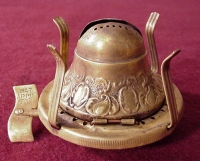
The UPTON Burner, highly embossed, in a rare zero size. Also made without the decorative embossing on the deflector.
This is Frank Rhind's patent no. D21,770,
patented on August 9, 1892, unassigned.
|
Charles S. Upton is known to have at least four patents. See the
patent table below for details. The Upton burner which bears his name is shown on the left. The "wavy" wick knob is marked THE UPTON on one side and PAT APPL FOR on the other. In the catalog, Upton claims that this burner will give one third more light than any other burner. He claims that the perforations, or holes, along the edges of the blaze hole, gives air to the surface of the flame, prevents forked corners, and keeps the flame steady. He further claims a brighter and better light than any duplex burner. Personally, I think he got carried away! The UPTON burner was most likely made by Bridgeport Brass as it is of the same design as other known Bridgeport Brass burners bearing the patent date August 9, 1892, M-BOSS-D, with the highly ornate burner cone, sans air holes.
Charles Upton died on February 17, 1897. The company continued on until around 1905 under the management of Upton's family members.
THE UPTON WILL
 The Testator Left a Large Amount of Real and Personal Property
The Testator Left a Large Amount of Real and Personal Property
The will of the late Charles S. Upton, of New York, whose sudden death from paralysis occurred in this city last February, has been admitted to probate by the surrogate of the county of New York. The will was a long document and disposed of property amounting to about $300,000 and located in places widely separated in the state. Mr. Upton was the president of the Rochester Lamp Company, with head offices in New York and branches in Chicago, Toronto, Paris and London. This entire business was given to his nephews, Charles and James Pomeroy. His two brothers in Spencerport, Elijah and John Upton, received some money, together with his interest in the old homestead in the same village. To his nephew, Fred S. Upton, he left his breeding stables and property on the Boulevard, together with his famous trotter "Vitello." The remainder of his estate, including his residence on Fifty-Second Street, New York City, his building property and blocks in Syracuse and Parma, and all patents and royalties of which he controlled a large number, were bequeathed to his widow.
-- Union & Advertiser, April 16, 1897
|
|
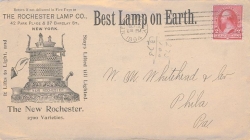
Postal Cover featuring The New Rochester
cancelled on Oct. 2, 1894 - the Bridgeport Brass era.
|
Starting sometime in 1884 and continuing through 1892,
Edward Miller & Company manufactured the "Rochester" line of lamps for The Rochester Lamp Company, located at 42 Park Place and 37 Barclay Street, New York City. Rochester billed themselves as "The largest wholesale and retail lamp store in the world," with branch stores in London, Paris and Chicago. Edward Miller produced, according to the catalog, 2000 designs and of variations of the Rochester, and in every manner of lamp - table, hanging store lamp, hanging library lamp, pull-down hall lamps, bracket lamps, night lamps, and more. After 1892,
The Bridgeport Brass Company was awarded the contract to manufacture the lamps for the Rochester Lamp Co., which were then branded "New Rochester" to distinguish them from the former.
In the 1888 H. Leonard & Sons Catalogue, there is an advertisement for the No. 2509 Glass Fount. This lamp is made on the same center draft principal as the other Rochester lamps, but it is made with a clear glass fount. The lamp depicted is a bracket or hanging lamp fount. It was also made as a
stand lamp. The ad text states, "With glass fount the oil can always be seen, and the price is less than for solid brass founts." With brass mountings they sold for $22.00 a dozen; with nickle or rich gold mountings, $25.00 per dozen.
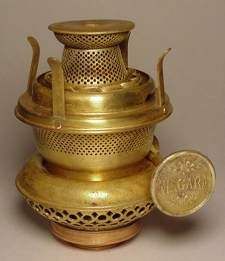
Shown above is a #2 NIAGARA Burner
depicted in Frank Rhind's #382,270,
Patent granted on May 1, 1888 |
Frank Rhind, a rather prolific inventor, is credited with seven patents which were assigned one-half to himself and one-half to Charles Upton. Rhind has at least thirty-nine patents to his credit, with the bulk of them, numbering some twenty-seven patents, having been assigned to Edward Miller & Company. Frank Rhind is noted as assignor of patents to both firms during the same period of time, interestingly, at a time when Edward Miller was engaged in the manufacture of their own lamps, as well as those of The Rochester Lamp Company. In today's business climate, a possible "conflict of interest."


| Patents assigned to Charles S. Upton, Dec. 29, 1886 - Mar. 27, 1894 |
| Patents of Frank Rhind |
| 382270 |
387258 |
440608 |
407492 |
342463 |
409706 |
333338 |
| Patents of Leonard Henkle |
| 365996 |
398725 |
412181 |
415108 |
435373 |
459440 |
. |
| Patents of Charles Upton |
| 427207 |
381042 |
474979 |
379836 |
. |
| Miscellaneous Patents |
| 517361 |
430584 |
. |
| D = Design Patent, RE = Reissue of an earlier Patent |
To view any of the above patents, enter the number in the box below and select Query USPTO Database. This will take you to the specific patent images on the U.S. Patent & Trademark Office Database. Learn more about the USPTO here.

- McDonald, Ann Gilbert. Brass Student Lamps and Night Lamps, Antiques & Collecting, January, 1984.
- The Illuminator, Volume 1, No. 2, The Historical Lighting Society of Canada, April 1987, p. 7, reprint of H. Leonard & Sons Catalogue.
- The Rochester Lamp Co., 1891-92 Sales Catalog
- The author would like to thank Renee Wagner for contributing newspaper clippings about The Rochester Lamp Company and images of Charles Upton and other family members.
 Search Rochester Lamp Co.'s Patents
Search Rochester Lamp Co.'s Patents